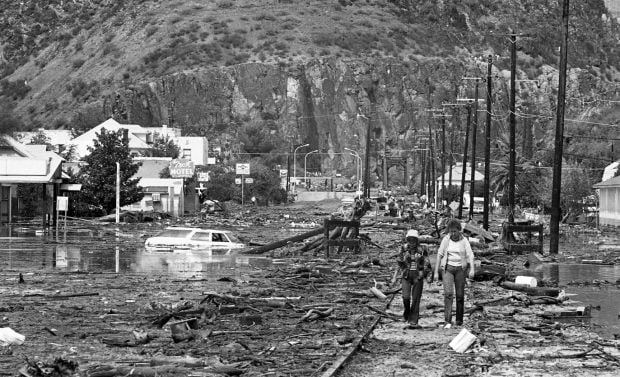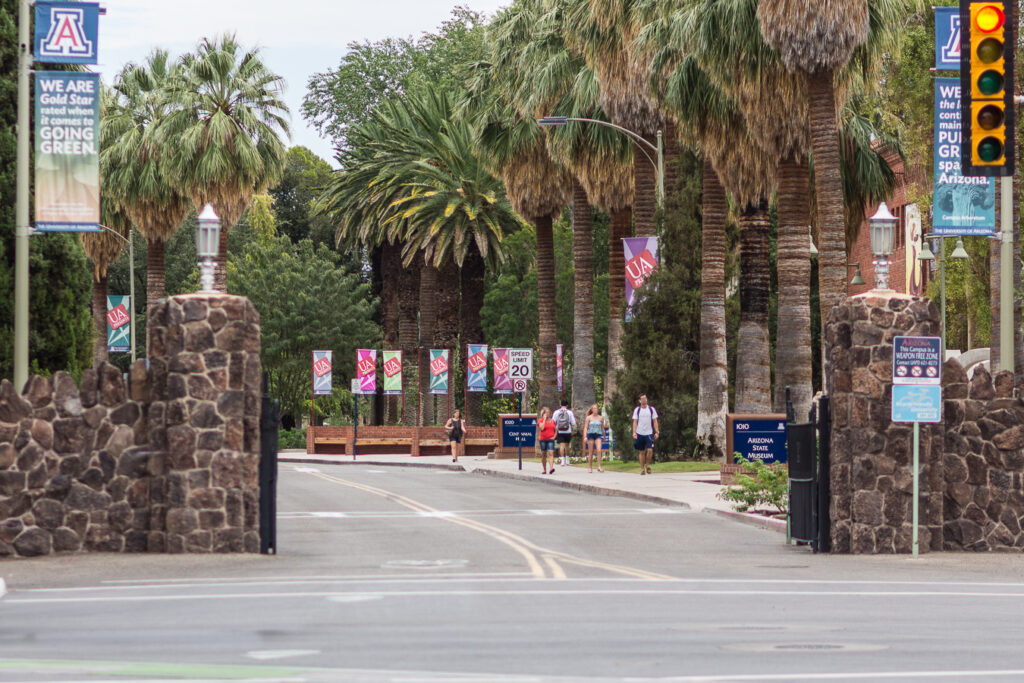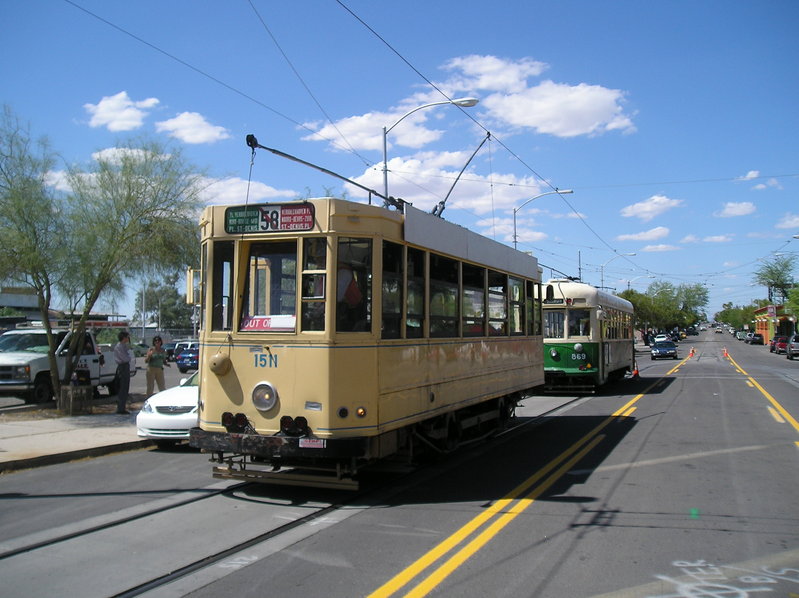-----
 |
| Two men inspect the damage left by tropical storm Octave, 1983 (Arizona Daily Star) |
 |
| The main gates at ASU Tucson, present day) (Real Tucson) |
The university's centennial was coming up in 1985, and to really ring in the big "100" with a bang, Centennial Celebration director Ruth Cross wanted to bring back an honored Tucson institution in time for the festivities. In 1983, she formed the Old Pueblo Trolley (OPT) non-profit to raise funds and coordinate with the city as well as to call on volunteers and equipment to eventually run the railway. Over the next two years, a one-mile stretch of track was recovered from the original Tucson Rapid Transit (TRT) from 5th and Broadway to the main University gate at Tyndall Street. The OPT also has the rare distinction of most its alignment being original street track dug up from the road, rather than being relaid or realigned.
To obtain a streetcar, the OPT turned to the Orange Empire Trolley Museum (OERM) in Perris, California, desiring something small and easy to operate. The OERM chose to lease ex-Pacific Electric Birney No. 332 to the fledgling operation for ten years, on the condition that the OPT restore the car to running order.
 |
| ex-Pacific Electric 332, as Tucson Rapid Transit 10, paused at the Alpine/Broadway platform at the OERM (Myself) |
Car 332 was originally built by Brill in 1918 for operation on the "boonie" lines in Pasadena, San Bernardino and Redlands, and retired from service in 1940. Following retirement, MGM purchased it and surviving sister 331 for use in films like Comrade X (1940) and, famously, Singing in the Rain (doubling for sister 337, which was sliced in half for interior shots). Following their film service, the cars were purchased by the Southern California Electric Railway Association (SC-ERA) and preserved in Perris, CA. The car would take over six years of hard work to restore out of that ten-year lease but it would first operate on OPT charter and member runs in 1991 as TRT No. 10.
 |
| Gene Kelly leaps off PE Birney 332's (or 331) roof to land safely in Debbie Reynold's car in "Singin' In the Rain". (MGM Studios) |
 |
| Ex-Hankai 225 operates on the OPT University Avenue stretch. (Jack Garcia) |
The next year, OPT would purchase ex-Hankai Tramway 255 from Osaka, Japan. This car was significantly younger, built in 1953 as Japanese City Lines 869. Upon retirement in 1992, OPT snatched it up and kept its Hankai Tramway identity. Due to the 869's pantograph and the 332/10's trolley pole, the overhead wire had to be configured primarily for trolley pole use (necessitating staggered and curved wire on corners). Volunteers from the Tucson Electric Power company helped put up the wires.
Public service began in 1993, way past the original centennial celebration, but it was still a cause to celebrate for Tucson: the town had its trolley back. In 1995, Car No. 10 returned to the OERM as the museum did not want to extend its lease, but the car continues to wear the green and cream of the Tucson Rapid Transit as a tribute to the little railway that helped it live again. A nine month period around the same time saw JCL 869 returned to service under its original number and roadname.
 |
| Ex-Brussells 1511 leads JCL 869 down an unknown Tucson street, 2009 (Ed Haven) |
Two more cars would join the fleet: ex-Brussells No. 1511 to replace 332 as the two-axle car, and a Toronto PCC. The Brussells car arrived in April of 1995 from Phoenix, AZ, after a plan to use it as a restaurant went belly-up. Toronto PCC 4608 reached Tucson in June, the next year, and would be gauged down from the weird Toronto-only gauge of 4 feet, 10 7/8 inches. The initial alignment operated until 2009, when an extension and loop was built at 5th avenue via the 4th avenue Underpass. This gave the OPT the ability to meet Amtrak trains and gain more foot traffic for both tourists and locals in the city. Old Pueblo also invested in a large historic bus collection, one of which (Bisbee Lines No. 8 from 1938) was operable by 2018.
 |
| The new Tucson sunlink at ASU's main gate on Park Ave. (Visit Tucson) |
However, trouble was soon brewing. In 2006, the "Sun Link" light rail program was begun after 60% of voters approved of the "Regional Transporation Plan". Much of OPT's single track alignments were now double-tracked across almost its whole route and a new maintenance facility would be constructed close to what is now the OPT's new carbarn. This meant that in 2011, the OPT's poles would go down under a suspension of service.
In the time since service suspension, the city of Tucson helped the OPT move into a former cabinet shop as their new carhouse in 2014. Currently, the OPT runs historic bus excursions using the aformentioned Bisbee Lines No. 8 (itself a native of Arizona) but hopes to one day continue operations by sharing tracks with the Tucson sunlink. Only time will tell if their poles are raised once again.
 |
| Old Pueblo Trolley's only operating piece of equipment right now: a 1938 White Coach Model 1204 for Warren Bisbee Bus Line, Arizona |
-----
Thank you for reading today's Trolley Thursday post! If you would like to find out more about the OPT beyond my hackneyed summary of their history, please visit their Facebook page, also follow the Tucson Historic Depot for more information, and as always: donations to them always help get them back on their wheels. As for me, all I can peddle is my Redbubble store if you want my doodles on your bodies. Until next time, ride safe!

No comments:
Post a Comment